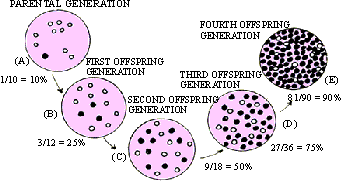|
PinkMonkey Online Study Guide-Biology
Living creatures show many adaptive features. For a fast
running body shape, lengthening of the limbs, loss of digits and foot
posture are modified. Burrowing animals show a spindle form body, sharp
nails and teeth, and short, strong, broad limbs for digging burrows. Aquatic
animals show streamlined shape of the body, aquatic respiratory organs
(gills), fins as locomotory organs. Flying animals show a streamlined
body form, pneumatic bones, feathers, wings, broad and strong sternum
and pectoral girdle for muscle attachment, well-developed brain and sense
organs, etc.
|
Natural selection operates in micro-organisms also. In the laboratory, bacteria resistant to streptomycin were developed. Their adaptation of streptomycin resistance helped them to survive and reproduce. Similarly a large number of flies have developed resistance to insecticides. Continued exposure to DDT enables the flies to develop resistance. Prolonged application of DDT down the generations selects combinations of genes that provide greater and greater resistance. Thus, continuous genetic recombination and selection results in the establishment of adaptive characters. |
Similar adaptations which occur in unrelated groups is
referred to as convergence, so that animals of different kinds
look similar (e.g. fish and whale show convergence). However some animals
of the same group show divergence and appear quite different from
each other. Divergent evolution is also called adaptive radiation
(Fig. 11.4). Animals show adaptations in the locomotory organs and appear
different. For example, limbs are modified for walking (mammals) flight
(in birds), and swimming (in whales).
(iii) Reproduction. Variations resulting after
recombinations or mutations may be favorable or unfavorable. Favorable
mutations may be described as adaptations. With natural selection
new adaptive characteristics get established in the population.
Differential reproduction or natural selection
Natural selection results not from direct struggle between
organisms, but only from differential reproduction. An organism survives
in an evolutionary sense by producing more offspring. Those that have
more offspring will contribute greater percentage of genes to the gene
pool than those that produce fewer offspring. Therefore, if differential
reproduction continues in the same manner over many generations, the abundant
reproducers will have a greater proportion of genes in the gene pool of
the population. Therefore, a new trait that originates in one generation
(black dots) spreads by differential reproduction, and becomes a standard
feature of the whole population. This is the unit of evolutionary change.
Many such units in a population accumulate and alter the organism, ultimately
recognized as a new species.
Suppose, in a population, a variation arises (11.5 A)
in one individual (black dot) and that variant organism produces
3 offsprings. The non-variant organisms (white circles) each produce only
one offspring. In the next generation there will be 3 variant types and
9 non-variant (11.5B) (i.e. 25% variants). In the third generation (11.5C)
there will be 9 variants and 9 non-variants (i.e. 50% of variant types).
In the fourth generation (11.5D) there will be 27 variants and 9 non-variants
(i.e. 75% of the total forms).

Figure 11.5 Black cells (dots) at are first less numerous and have higher reproductive rate; by fourth generation they outnumber white circle. Differential reproduction rates have changed the heredity of the population.
In this manner the proportion of variant organisms goes
on increasing and becomes a standard feature of the whole population.
The individuals with suitable characters (favorable adaptations)
are healthier and will produced more offspring. Thus, differential
reproduction (described as ’selection’ by Darwin) plays an
important role in evolution.
(iv) Speciation. Speciation in simple terms means origin or evolution of new species. Before we study about speciation we must know what a species is. "A species may be defined as a group of physically, biochemically and behaviorally similar organisms that are capable of breeding with each other but not with members of another species." In other words a species is a group of fertile organisms that can interbreed and produce fertile offsprings only among themselves.
|
A population is a group of interbreeding
individuals (i.e., a species). A species may be subdivided into
subspecies, races, varieties, demes, etc. A deme is an
interbreeding subunit of species. If demes are isolated (geographically)
they can give rise to new species. A variety is a subtype
within a deme (e.g. different types of roses). A race is
a genetically distinctive interbreeding group within the species.
Several human races such as caucasians (European and other white
races, Arabs, Egyptians and Indians), Negroid (Black Africans),
Mongoloid (Chinese, Japanese, Koreans), etc. were applied term
for once isolated geographical populations of interbreeding individuals
which gave rise to common characteristics such as appearance,
skin color, body build etc.due to deisolation of populations by
migration via modern travel, these terms are becoming obsolete.
Subspecies consists of races and includes several populations.
|
Gene Pool (Figure 11.6). Population is a geographically
localized group of individuals of the same species. A total collection
of all genes in a population is called a gene pool. Thus, gene
pool will have all genotypes, (i.e. genes of the organisms within that
species).

Figure 11.6 The Gene Pool
A population in which the gene pool changes undergoes evolution.
This change can take place due to recombination, mutations or by natural
selection. If genes are exchanged between two different populations it
is called gene flow. New genes are introduced in local populations
by immigration of individuals of the same species by gene flow.
|
Table of Contents
11.0 -
Introduction
11.1 Darwin's Theory of Natural Selection
Chapter 12
|